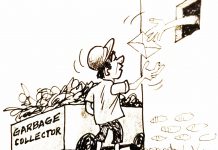
ASSOCIATE PROFESSOR III
Diversification: Encouraging diversification of crops can reduce the country’s heavy reliance on rice. Promoting other staple foods can enhance food security . Is there a need for this approach?
Today, I was feeling a bit feverish perhaps due to the very hot weather on a 70 Kilometer drive. Lunch was a needed respite to recharge and be ready for the task of teaching and even leading hundreds of faculty and employees.
The food that I have is Tinola, a generous Buraw-buraw in Bell Pepper and Chinese Pechay, however, there was no rice in the table. I was about to buy two cups of rice because the one cup of yesteryears is 2 cups nowadays. I ultimately decided against rice, I will consume the fish and the generous accompanying soup and its going to be just fine, I thought.
I was not mistaken, I feel okay and even full, no rice was consumed and I remember it may be a thing that I can be used to, no more rice diet.
Then I recall the news the other night, how rice was being used as a get rich scheme for the profiteers and hoarders . And how an agency is allegedly making millions due to the fact that they allegedly create practice that put the government in a disadvantage and the people, deprived of the staple food.
Here is a quick round up of web results about the Rice Situation on the country :
1. Rice Supply Situation:
o In December 2023 and January 2024, a total of 750,000 metric tons of imported rice arrived in the country 1.
o The country’s rice supply is currently sufficient through the first half of 2024, thanks to recent imports and the upcoming harvest that peaks in March and April 2.
o However, there are concerns about profiteers who may exploit the situation by hoarding rice supply and driving local prices unreasonably high 1.
2. Challenges and Hostage Situation:
o Rice is a staple food in the Philippines, and its importance cannot be overstated. Unfortunately, this overblown significance has allowed the rice sector to hold the rest of the country hostage to its short-term and short-sighted demands.
o The rice sector’s dysfunctional state has hindered progress in agricultural development, food security, and overall economic growth 3.
3. Potential Solutions:
o Transparency and Regulation: Stricter regulations and transparency measures are essential to prevent hoarding and price manipulation. Authorities should closely monitor rice supply chains and take action against profiteers.
o Diversification: Encouraging diversification of crops can reduce the country’s heavy reliance on rice. Promoting other staple foods can enhance food security.
o Investment in Agriculture: Investing in modernizing agriculture, improving irrigation systems, and supporting farmers can boost productivity and stabilize supply.
o Public Awareness: Educating the public about the importance of sustainable rice consumption and the need to avoid panic buying during shortages is crucial.
In all, I will go for alternatives to Rice, as it is even attributed to the high incidence of Diabetes and Hypertension. Perhaps, its time we unlearn the palate, hard but realizable . It can be healthier, too.!



